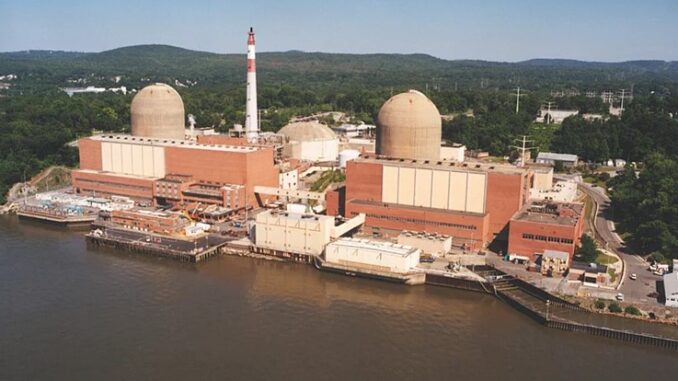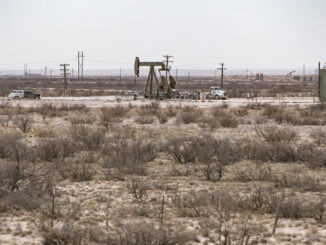
Energy News Beat Publishers Note (ENB): What is the increased cost to the consumers of the additional kWh that is required to bring in renewable energy? The Indian Point Nuclear Generator is being taken offline years ahead of planned obsolescence. All this does is cost the consumers and not help the environment – just saying…
New York will mark a milestone in the state’s evolving energy landscape when the Indian Point nuclear power plant, located just north of New York City, permanently closes this week. The plant’s history of operational, safety, and environmental problems, as well as the grave risk of a nuclear accident so close to the nation’s largest city, have long cast a shadow on the region. And because of New York’s landmark 2019 climate legislation and years of clean energy planning and investments by the state, New York is better positioned today than ever to achieve its ambitious climate and clean energy goals without this risky plant.
Why Is Indian Point Closing?
In 2017, Indian Point’s owner, Entergy, voluntarily entered into a negotiated agreement with New York State and the environmental group Riverkeeper, which ended a ten-year legal proceeding about whether the expired operating licenses for Indian Point’s two reactors should be renewed. Through the 2017 agreement, Entergy agreed to close Unit 2 on April 30, 2020, and to close Unit 3 on April 30, 2021. Entergy has noted that its decision to enter into the agreement to close the reactors reflected a number of factors, including reduced revenues from the plant due to New York’s competitive wholesale electricity markets.
Indian Point Presents Unique Siting, Public Health, and Safety Risks
The Indian Point nuclear plant, located in the most densely populated part of our country, presented a unique set of risks. For decades, the plant had one alarming incident after another, including missing and damaged bolts on the structures in both reactors that surround and are critical to cooling the nuclear fuel, a May 2015 transformer fire which sent thousands of gallons of oil into the Hudson River, radioactive spills and releases into the Hudson River and groundwater, failed accident drills, and inadequate disaster planning. The power plant’s two operating units lie within a mile of a significant seismic zone discovered after the plant was built in the 1960s, prompting the Nuclear Regulatory Commission (NRC) to deem Indian Point one of the top ten facilities most in need of reevaluation for earthquake vulnerability. One of the 9/11 terrorists cited the plant as a potential target. Indian Point’s proximity to New York City and the rest of the densely populated tri-state area made the potential impacts of an accident severe. My colleague Matthew McKinzie, a nuclear physicist and director of NRDC’s Nuclear team, laid out potential severe nuclear accident consequences here. Because of these risks to public health and safety, NRDC has long opposed relicensing Indian Point.
Electric System Reliability Will Be Maintained
New York’s electricity supply will continue to be reliable after the closure of the plant. The New York Independent System Operator (NYISO)—which is charged with ensuring the reliability of New York’s electric grid and running our wholesale electricity markets—conducted a reliability assessment and concluded that Indian Point can retire on schedule without impacting electric system reliability.
New York Is on Track to Meet Its Aggressive Climate and Clean Energy Goals
In 2019, New York State enacted ambitious climate and clean energy legislation called the Climate Leadership and Community Protection Act (CLCPA), which includes economy-wide mandatory carbon reduction and clean energy goals. The CLCPA mandates that New York’s electricity system must be 70 percent renewable by 2030 and 100 percent zero carbon by 2040. And it includes groundbreaking equity provisions to ensure that climate and clean energy benefits are realized by environmental justice communities. The CLCPA also includes nation-leading climate and clean energy mandates for solar power, offshore wind, battery storage and energy efficiency. Significantly, energy modeling done for the state, which assumes the retirement of Indian Point, confirms that these goals are achievable.
RGGI Also Ensures Continued Regional Carbon Reductions: New York is also part of the Regional Greenhouse Gas Initiative (RGGI)—an East Coast eleven-state initiative which requires reductions in power sector carbon pollution through a mandatory and enforceable regional cap on overall power plant carbon pollution. In 2017, New York and the other RGGI states further strengthened the carbon cap, committing to a 65 percent reduction in power plant carbon pollution by 2030, relative to 2009. The RGGI states have already made significant progress toward that goal: power plant carbon pollution in those states has been cut by more than half since the program began. Significantly, in the modeling that went into charting this carbon trajectory for the program, New York already built in the retirement of Indian Point, meaning the region will stay on track with the required carbon pollution reductions without this plant.
New York’s Clean Energy Progress: Moving Into High Gear
Significantly, New York’s electricity grid today is much transformed since the debate over Indian Point’s future began decades ago. The grid has made great strides toward becoming much cleaner, more efficient, and more flexible, and that progress is now accelerating, although there is still much more that needs to happen.
The Grid Is More Efficient: New York’s ambitious energy efficiency policies are helping to make energy usage more efficient and reduce load growth projections. A recent draft NYISO report predicts that electricity load growth and demand growth rates in New York will be lower than expected over the next decade, because of strong federal and state energy efficiency programs, the growth of rooftop solar, and the economic impacts of the COVID-19 pandemic, although they will increase after 2030. We need to double down on energy efficiency going forward as we electrify buildings and transportation.
Renewable Electricity Is Growing Rapidly: In 2020, renewable electricity was about 27 percent of New York’s electricity mix. Wind and solar power are beginning to grow rapidly in the state. New York’s wind generation doubled between 2009 and 2019. There has been incredible growth in New York solar power capacity, which now totals over 2.8 gigawatts installed capacity—with 1,800 percent growth since 2011 (as of last year). Policies such as the Accelerated Renewable Energy Growth and Community Benefit Act, enacted last year and the establishment of New York’s new Office of Renewable Energy Siting will help to further accelerate renewables growth and meet CLCPA mandates. And New York continues to take bold action to install offshore wind in the waters off New York State, with yearly competitive bid processes. The state’s 2020 offshore wind solicitation resulted in two offshore wind contracts for capacity over 2.4 GW in total capacity. Between renewable projects already built and those that have received contracts from the state and are under development (including offshore wind), New York is well on its way to achieving the CLCPA’s requirement that 70 percent of the state’s electricity come from renewable resources by 2030.
As one point of comparison, in September 2019, New York State estimated that the combined energy efficiency and renewables gains over the preceding decade (achieved and projected by 2021) already exceeded the annual output of the Indian Point plant.
The Grid is More Flexible: Today, there are over 1.2 gigawatts of demand response resources on the New York grid. These programs, which compensate customers for agreeing to cut their electricity use when called upon during periods of high use, are in place to cut electric power on peak summer days. New York is investing in battery storage as another important source of grid flexibility and balance. The state is also engaged in strengthening transmission capacity, as I explained in a previous blog.
The CLCPA Requires New York to Continue to Move Off Fossil Fuels
The CLCPA requires that 100 percent of New York’s electricity be carbon free by 2040. That means New York must take action to phase out reliance on fossil fuel generation within two decades. While there is much more that needs to be done, the state is making progress and will continue to do so after Indian Point is retired.
Overall, according to Energy Information Administration data, fossil fuel’s share of New York’s electricity generation declined significantly between 1990 (when it made up 60.9 percent of the state’s generation) and 2020 (40.4 percent). In 1990, coal-fired generation accounted for almost 20 percent of the state’s electric generation; today, New York has completely phased out coal power plants. Oil-fired power generation has also declined from 25 percent of the state’s generation mix in 1990 to less than 1 percent in 2020.
Gas-fired power’s share of the generation mix has grown over the decades; after reaching highs in 2012 and 2016, it has declined since 2016 with some fluctuations. As some have noted, last year, when the first Indian Point reactor closed, gas-fired power generation levels increased somewhat from 2019—but these levels were still lower than in 2016. And drawing the simplistic conclusion that the retirement of the first Indian Point reactor was the one-to-one cause for the increase doesn’t hold water. New York’s competitive wholesale electricity markets, which determine which power plants are called on to run at which times, are driven by complex factors ranging from fuel costs to energy usage patterns to transmission constraints. Because of reduced energy demand due the COVID-19 pandemic, gas prices fell to record lows across the U.S in 2020. As a result, gas generation increased not only in New York, but nationwide, going from 38 percent of the U.S. electricity mix in 2019 to 40 percent of the mix in 2020. In total, 34 states saw gas increase as a share of their generation mix in 2020, although only one other state (Iowa) closed a nuclear plant last year.
As I noted last year, New York State is also acting to reduce health-harming air pollution from fossil fuel “peaker” power plants, which operate during the periods of highest electricity demand. Shuttering these peaker plants is a key climate equity and environmental justice requirement. Just this month, the Public Service Commission approved three Con Edison transmission lines which will allow the closure of several dirty New York City peaker plants while maintaining reliability.
New York must now put in place the increasingly stringent air quality regulations, clean energy policies, and the overall regulatory framework that is required to put gas-fired generation on the steep decline needed to meet the CLCPA’s mandates —policies that are necessary with or without Indian Point.
Next Steps
Make no mistake, we need to continue to engage in smart planning, innovative policy development and hard work to ensure that New York State meets its aggressive climate goals, phases out fossil fuels, and protects public health and air quality, with special focus on environmental justice communities. Indeed, we must redouble these efforts.
Importantly, we also need to ensure that the community around Indian Point and the workers at the plant are supported in the transition to a future without the nuclear facility. New York State and Entergy have made commitments to the community and plant workers which must be met. In 2015, New York State created a Cessation Mitigation Fund to assist communities impacted by power plant closures. This will be one source of community support after Indian Point closes.
Finally, we must meet the challenge of cleaning up the Indian Point site and dealing with the nuclear waste that is currently housed there. Many years will be spent decommissioning Indian Point after a half century of operation; New York State and the environmental community need to work hard to ensure a thorough cleanup. And we still have the challenge of the nuclear waste that will remain on site until there is a national solution. At Indian Point, this process will start with defueling Unit 3 and removing spent nuclear fuel from wet pools to dry cask storage, where it will remain until permanent deep geologic disposal is permitted. NRDC has charted a course forward to address this issue, with reliance on bedrock environmental laws.
Conclusion
There’s no question that Indian Point was sited in the wrong place some 50 years ago—a location where a severe accident would jeopardize the health of millions of people and where no large-scale evacuation plan would be remotely feasible. The closure of Indian Point this week ends this risky chapter. The retirement will happen on schedule with no red flags from reliability monitors at NYISO, and against the backdrop of accelerated climate and clean energy progress in New York State that was almost unimaginable when the debate over Indian Point began decades ago.
Many of NRDC’s valued allies and determined partners have fought long and hard to close Indian Point, to push back on fossil fuels and to move New York forward on clean energy, including Riverkeeper, Alliance for a Green Economy, Frack Action, Nuclear Information and Resource Service, Food and Water Watch, Clearwater, Scenic Hudson and many others. It’s been an honor for NRDC to work with these tireless advocates.



